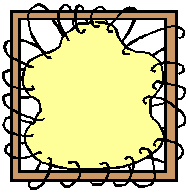
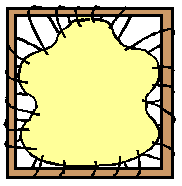
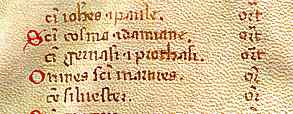
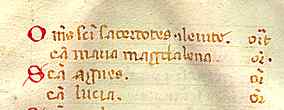
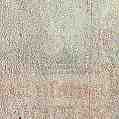
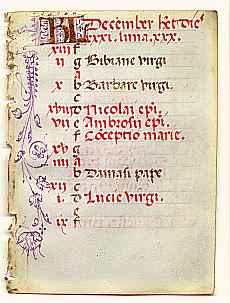

If you are looking at this page without frames, there is more information about medieval writing to be found by going to the home page (framed) or the site map (no frames).
| Parchment | ||||||
| The usual material for writing on in medieval books or documents was parchment or vellum. This was made from the skin of sheep, goats or calves. The skin was not tanned in the manner of leather as used in shoes or belts or bags, a process which in the medieval period utilised an extraordinary concoction of noxious substances, but received a particular form of extended treatment to make it fine, supple, flat and white. | ||||||
 |
The skin was soaked in a caustic solution which dissolved out fat and helped clean away adhering tissue. It was then laced to a wooden frame. | |||||
 |
The lacings were progressively tightened to stretch the skin, while the hide was repeatedly scraped with a knife, not only to remove any extraneous matter, but also to keep the skin supple as it stretched and dried. As anybody who has wandered over a sheep paddock knows, a skin which dries out without this suppling treatment becomes as hard as a board. | |||||
| When the treatment was complete, the hair side of the skin could be distinguished from the flesh side by colour, texture and by the fact that the hair side tended to become slightly concave. Now before you protest that this would mean that the animal had been inside out, this occurs because the fibres in the skin are tougher and less inclined to stretch than those of the flesh side, so that the pummelling that the skin received during its treatment tended to cause it to bulge the other way than when it was wrapped around the beast. The designation of the hair side and the flesh side is sometimes made in codicological descriptions. | ||||||
 |
Segments of two sides of a leaf from a 15th century Italian book of hours, from a private collectrion. | |||||
| The examples at left, from a rather scruffy little book of hours, clearly show the difference between the hair side at the top, slightly brownish with the hair follicles visible, and the smoother and whiter flesh side at the bottom. | ||||||
 |
||||||
| Sometimes the hide was scrubbed with pumice stone to smooth it and cause it to stretch out thinner. This tended to obliterate the difference between the skin and hair sides. The skin could also have chalk rubbed into it while it was on the frame to whiten it. Thick skins, like calf, could sometimes be split into two layers; a skilled and exceedingly tricky procedure, I imagine. | ||||||
 |
A sample of vellum in a book of hours (National Library of Australia, MS 1097/9, f.72r), by permission of the National Library of Australia. | |||||
| The above example might not look very exciting as it is a picture of a blank section of page, but what you can see is a bit of rubric lettering and part of a miniature on the following recto page, not the verso of this page, the vellum having been worked so fine as to be translucent. | ||||||
 |
Calendar page from a 15th century Italian book of hours, from a private collection. | |||||
| The parchment or vellum of this Italian book of hours, just as tiny but much more elegant than the example shown above, has been worked very smooth and whitened so that it is flat and even, and it is no longer possible to differentiate the hair side from the flesh side. | ||||||
 |
Small segment from a page from a 13th century miniature Bible, from a private collection. | |||||
| In the 13th century, the production of compact portable Bibles containing the complete text of the Old and New Testaments required the production of vellum that was incredibly thin and even. The vellum of the example at left is fine and translucent, like tissue paper, but tough enough to withstand 700 years or so of use. The amount of skill, care and sheer work required to produce such a result from a piece of hide is mindboggling. | ||||||
|
|
||||||
|
If you are looking at this page without frames, there is more information about medieval writing to be found by going to the home page (framed) or the site map (no frames). |
||||||